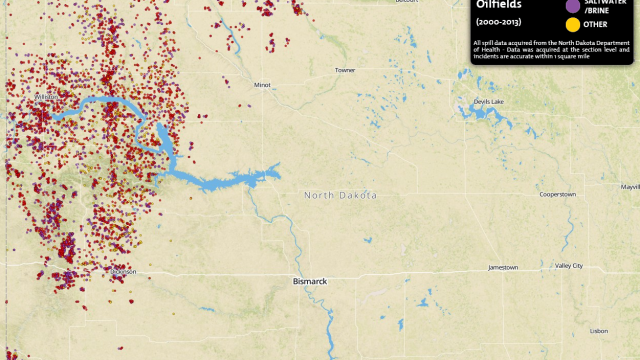Map Shows Bakken Oil Spills In North Dakota

After the Tesoro oil spill near Tioga, the media (lead by the Associated Press) threw a collective hissy fit because the State of North Dakota wasn’t sending out a press release each and every time a spill happened. Of course, that data was always public record obtainable upon request from the State Department of Health, but nobody in the media was asking for it.
Which didn’t stop Associated Press reporter James MacPherson from writing an indignant feature story about how there were hundreds of Bakken oil spills in North Dakota that weren’t reported to the public. Of course, the only reason they weren’t being reported to the public is because reporters like MacPherson weren’t covering the story.
What that sensational coverage, fanned by the winds of partisan politics and anti-oil activism in the state, has resulted in is a perception in North Dakota of oil spills being a major problem. Something the map above, created by Gage Cartographics, perpetuates.
“I know that is supposed to ‘scare’ people,” the reader who sent me the map writes, “but I actually think it does the opposite and put into perspective the amount that has already been spilled … and how little damage any of it has done.”
I’m not sure everyone will get that message. There are people (usually people who have never actually visited western North Dakota) who believe today that the oil patch has become a blighted wasteland, which simply isn’t true.
But there are some facts about this map that are worth keeping in mind.
- You’re looking at more than a decade of spills. Nearly 15 years, in fact.
- Most of the spills are very small. Less than 100 gallons of oil, or a little over 3 barrels of oil.
- Most of the spills happened at well sites, where spills are prepared for. Thus, most of these spills had almost no environmental impact.
One of the positives that came out of the Tioga oil spill is that the Department of Health is now publishing an online database of spills, and as you can see at that database, most of these spills are minor.
It’s unfortunate that the intensly political nature of fossil fuel energy development results in the public being mislead by sensationalism, but the nice thing about this modern age of media is that the truth is usually just a few mouse clicks away for those willing to look.
Update: Apparently the map was commissioned by the Dakota Resource Council, a left-wing anti-oil group.




